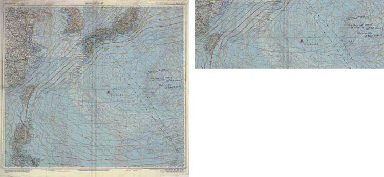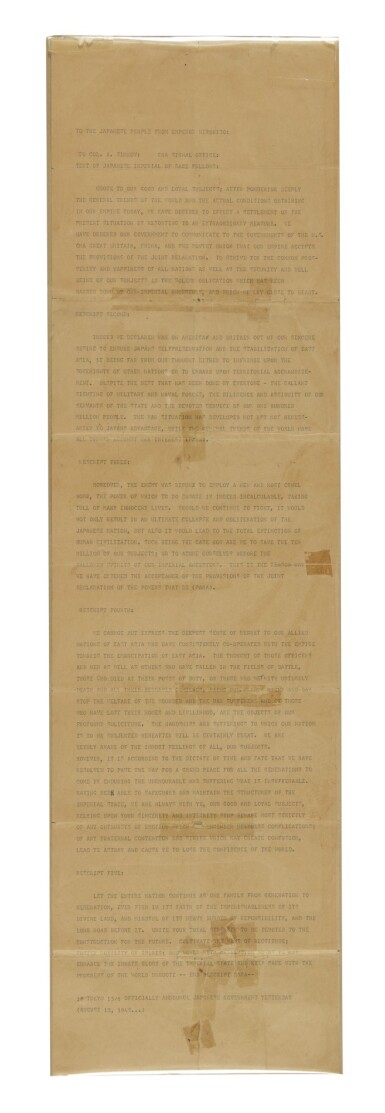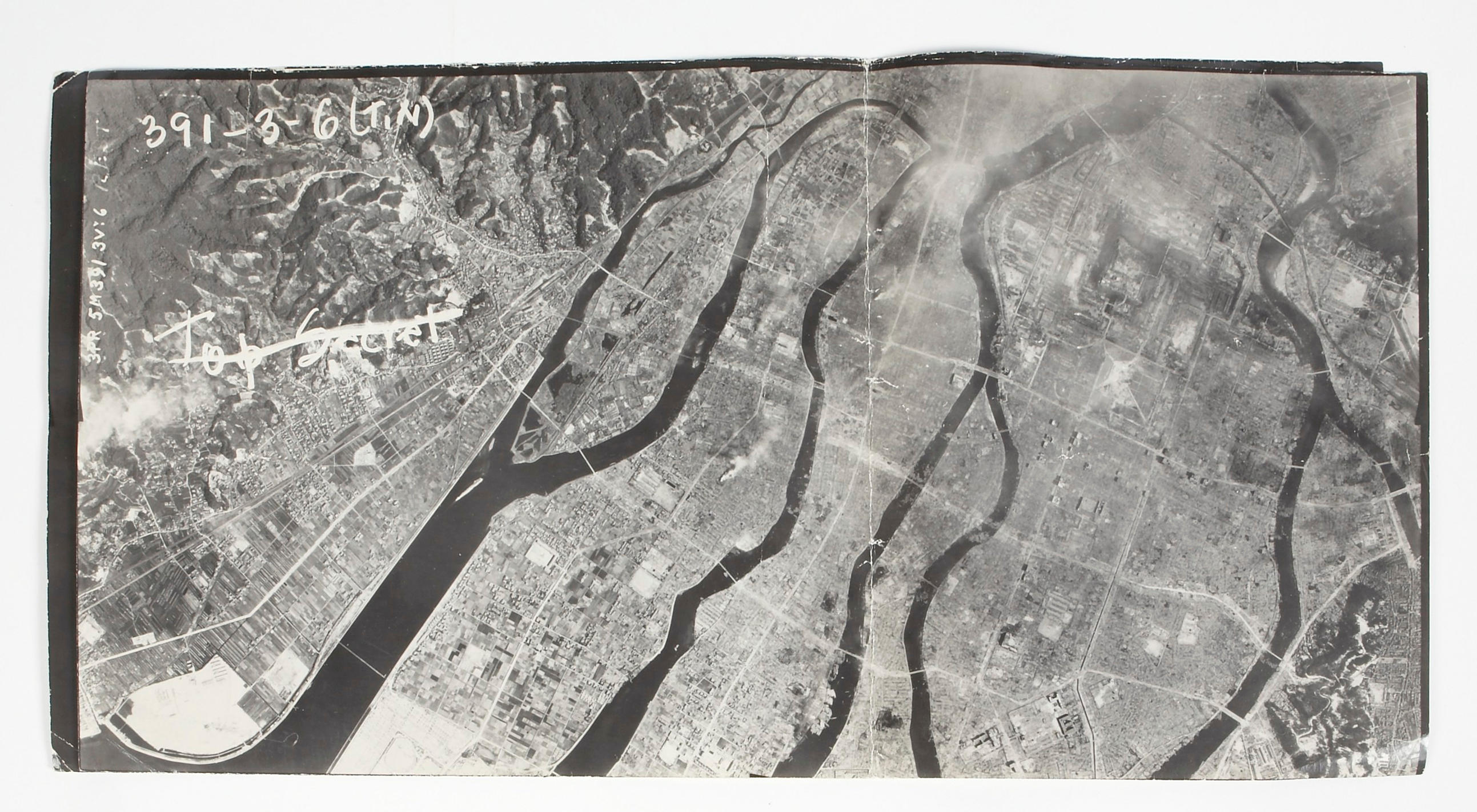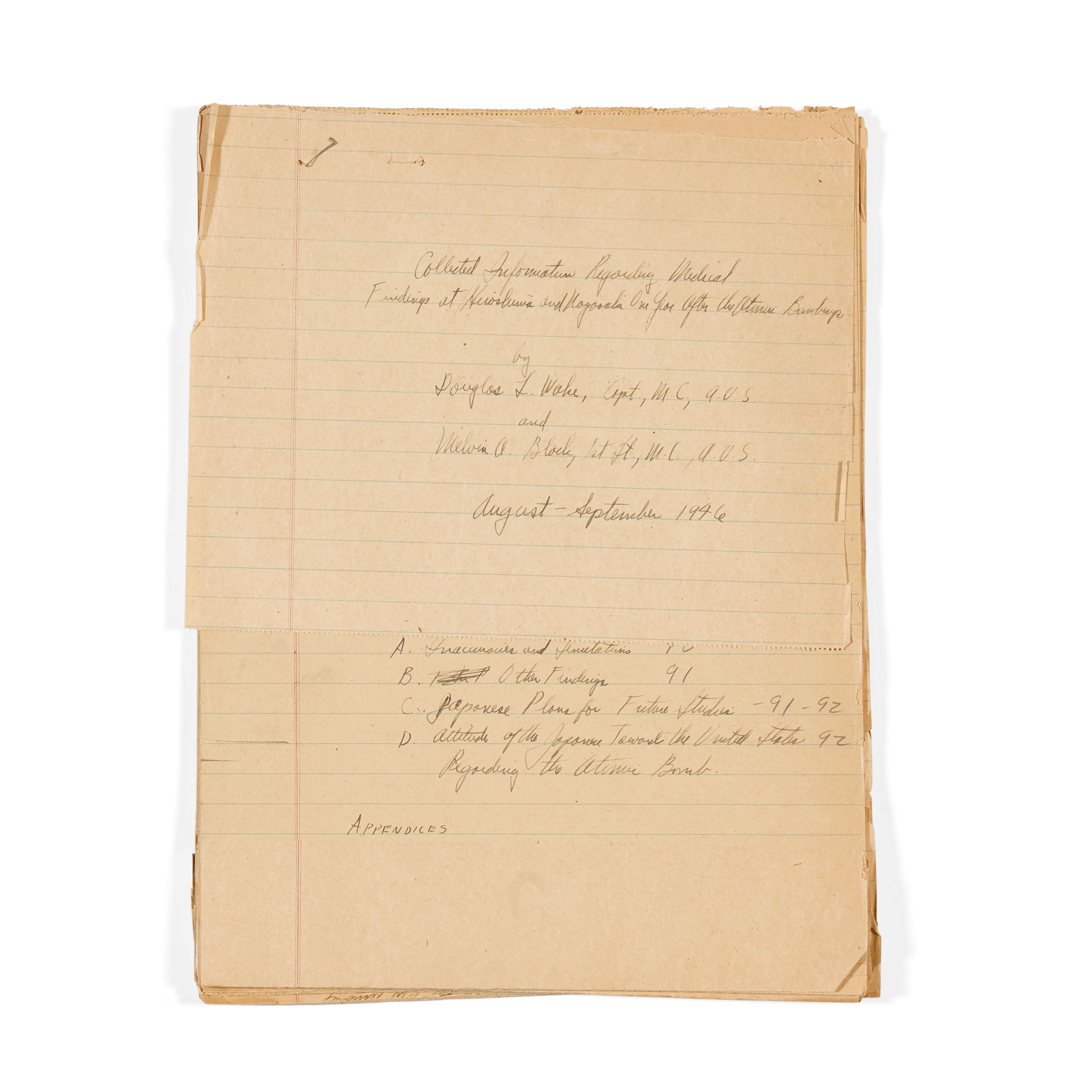WORLD WAR II, HIROSHIMA BOMBING]. LEWIS, Robert A., Captain, U.S. Army Air Corps, Co-pilot of the B-29 bomber the Enola Gay . Autograph logbook signed, entitled "Bombing of Hiroshima Aug. 6, 1945," containing a minute-by-minute account of the historic "Little Boy" mission which dropped the world's first atomic bomb on the city of Hiroshima, WRITTEN IN FLIGHT OVER THE PACIFIC AND OVER THE TARGET, 6 August 1945. 11 pages (comprising front and back covers, inside front cover and 8 text pages), small folio (9¼ x 6 in.), in ink and pencil in a War Department "Line of Position" notebook, bound in cloth-backed paper wrappers, 14 additional text pages with Lewis's "History of the 509th Bomb Group" (10 August 1945), upper cover with Lewis's hand-lettered title, a list of the crew, etc., REAR COVER WITH LEWIS'S SIGNED PENCIL SKETCH OF THE MUSHROOM CLOUD OVER HIROSHIMA (labeled with time: 0930 hours), minor wear to wrappers, corners bumped, otherwise in excellent condition. "MY GOD WHAT HAVE WE DONE...THE GREATEST EXPLOSION MAN HAS EVER WITNESSED": THE VIOLENT BIRTH OF THE ATOMIC AGE: THE "ENOLA GAY" CO-PILOT'S IN-FLIGHT LOGBOOK OF THE MOMENTOUS MISSION WHICH DELIVERED "LITTLE BOY," THE FIRST ATOMIC BOMB, TO HIROSHIMA, AUGUST 6, 1945 The atomic age, some would say, began with crucial early experiments by scientists including Niels Bohr, Lise Meitner, Enrico Fermi and Robert Teller in the late 1930s, or with Albert Einstein's and Leo Szilard's famous letter of August 2, 1939 (see lot 161) warning President Franklin D. Roosevelt that "extremely powerful bombs of a new type" might be created from the physicists' new understanding of atomic theory and the application of his own famous equation of equivalence E=mc 2 . The Manhattan Project was initiated in response to that letter, and its massive, secret research and production efforts culminated in the fall of 1945 in the operational deployment of "Little Boy," the world's first atomic weapon. For most of us, though, the atomic age begins with a single cataclysmic event: the detonation of the first atomic bomb over the Japanese city of Hiroshima, at 8:16 a.m., August 6, 1945. Lewis's log is a unique first-hand record of the violent birth of the atomic age. It constitutes--with the sole exception of the navigator's log, which numerically recorded the aircraft's course, airspeed, latitude and longitude--THE ONLY IN-FLIGHT, FIRST-HAND ACCOUNT OF THE BOMBING OF HIROSHIMA. The B-29 chosen for the momentous mission, with the name Enola Gay in large letters on its nose, took off in pre-dawn darkness from the U.S. airbase at Tinian Island in the Marianas at 2:45 a.m. Piloting the four-engine aircraft was Col. Paul Tibbetts, the Commanding Officer of the 509th Composite Group, a unit specially formed and trained in the highest security for this special mission. Flying as co-pilot was Capt Robert A. Lewis of Brooklyn, New York. In the aircraft's bomb-bay rested a single 9,000-pound bomb unlike any other ever carried into combat. The youthful ten-man crew had trained for almost a year for this "very special mission" that "might end the war," but only Col. Tibbetts and the radio operator had detailed knowledge of the nature and potential destructive power of the mysterious weapon they carried. In fact, not even the team of scientists who had designed, built and installed the bomb knew whether the device would explode as planned, or could calculate its destructive potential. The crew and the two special technicians who accompanied them on this flight had been advised, though, of the possibility that the airplane itself might be blown apart when the bomb detonated. If they experienced engine failure or were shot down, Col. Tibbetts carried cyanide capsules to distribute to each man to prevent their revealing, under interrogation, anything about the top-secret weapon or their mission. On the inside cover, two days after the mission, Lewis explains the creation of this unique historic record: "This l
WORLD WAR II, HIROSHIMA BOMBING]. LEWIS, Robert A., Captain, U.S. Army Air Corps, Co-pilot of the B-29 bomber the Enola Gay . Autograph logbook signed, entitled "Bombing of Hiroshima Aug. 6, 1945," containing a minute-by-minute account of the historic "Little Boy" mission which dropped the world's first atomic bomb on the city of Hiroshima, WRITTEN IN FLIGHT OVER THE PACIFIC AND OVER THE TARGET, 6 August 1945. 11 pages (comprising front and back covers, inside front cover and 8 text pages), small folio (9¼ x 6 in.), in ink and pencil in a War Department "Line of Position" notebook, bound in cloth-backed paper wrappers, 14 additional text pages with Lewis's "History of the 509th Bomb Group" (10 August 1945), upper cover with Lewis's hand-lettered title, a list of the crew, etc., REAR COVER WITH LEWIS'S SIGNED PENCIL SKETCH OF THE MUSHROOM CLOUD OVER HIROSHIMA (labeled with time: 0930 hours), minor wear to wrappers, corners bumped, otherwise in excellent condition. "MY GOD WHAT HAVE WE DONE...THE GREATEST EXPLOSION MAN HAS EVER WITNESSED": THE VIOLENT BIRTH OF THE ATOMIC AGE: THE "ENOLA GAY" CO-PILOT'S IN-FLIGHT LOGBOOK OF THE MOMENTOUS MISSION WHICH DELIVERED "LITTLE BOY," THE FIRST ATOMIC BOMB, TO HIROSHIMA, AUGUST 6, 1945 The atomic age, some would say, began with crucial early experiments by scientists including Niels Bohr, Lise Meitner, Enrico Fermi and Robert Teller in the late 1930s, or with Albert Einstein's and Leo Szilard's famous letter of August 2, 1939 (see lot 161) warning President Franklin D. Roosevelt that "extremely powerful bombs of a new type" might be created from the physicists' new understanding of atomic theory and the application of his own famous equation of equivalence E=mc 2 . The Manhattan Project was initiated in response to that letter, and its massive, secret research and production efforts culminated in the fall of 1945 in the operational deployment of "Little Boy," the world's first atomic weapon. For most of us, though, the atomic age begins with a single cataclysmic event: the detonation of the first atomic bomb over the Japanese city of Hiroshima, at 8:16 a.m., August 6, 1945. Lewis's log is a unique first-hand record of the violent birth of the atomic age. It constitutes--with the sole exception of the navigator's log, which numerically recorded the aircraft's course, airspeed, latitude and longitude--THE ONLY IN-FLIGHT, FIRST-HAND ACCOUNT OF THE BOMBING OF HIROSHIMA. The B-29 chosen for the momentous mission, with the name Enola Gay in large letters on its nose, took off in pre-dawn darkness from the U.S. airbase at Tinian Island in the Marianas at 2:45 a.m. Piloting the four-engine aircraft was Col. Paul Tibbetts, the Commanding Officer of the 509th Composite Group, a unit specially formed and trained in the highest security for this special mission. Flying as co-pilot was Capt Robert A. Lewis of Brooklyn, New York. In the aircraft's bomb-bay rested a single 9,000-pound bomb unlike any other ever carried into combat. The youthful ten-man crew had trained for almost a year for this "very special mission" that "might end the war," but only Col. Tibbetts and the radio operator had detailed knowledge of the nature and potential destructive power of the mysterious weapon they carried. In fact, not even the team of scientists who had designed, built and installed the bomb knew whether the device would explode as planned, or could calculate its destructive potential. The crew and the two special technicians who accompanied them on this flight had been advised, though, of the possibility that the airplane itself might be blown apart when the bomb detonated. If they experienced engine failure or were shot down, Col. Tibbetts carried cyanide capsules to distribute to each man to prevent their revealing, under interrogation, anything about the top-secret weapon or their mission. On the inside cover, two days after the mission, Lewis explains the creation of this unique historic record: "This l







.jpg)






Try LotSearch and its premium features for 7 days - without any costs!
Be notified automatically about new items in upcoming auctions.
Create an alert